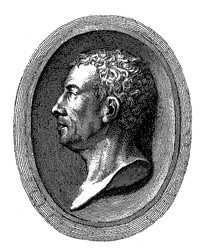Odysseus, bärtig und langhaarig, ist die zentrale Gestalt, die auf jeder Seite von zwei Sirenen mit großen Frauenbrüsten eingefasst ist. Unterhalb der Brüste besitzen sie Vogelkörper. Ein Totenkopf zu ihren Füßen ist Zeichen ihres mörderischen Geschäfts. Odysseus, nackt bis auf einen hochgeschobenen Helm mit Seeschlitzen, ist ihnen durch seine Größe körperlich gleichgestellt. Seine fünf Gefährten sitzen bzw. stehen an den Rudern, sie sind bekleidet und tragen Helme.
Bezeichnet:
u.r.: Ronald Paris 77
u.l.: "Odysseus und die Sirenen" (I)
u. Mitte: 9/23
en

